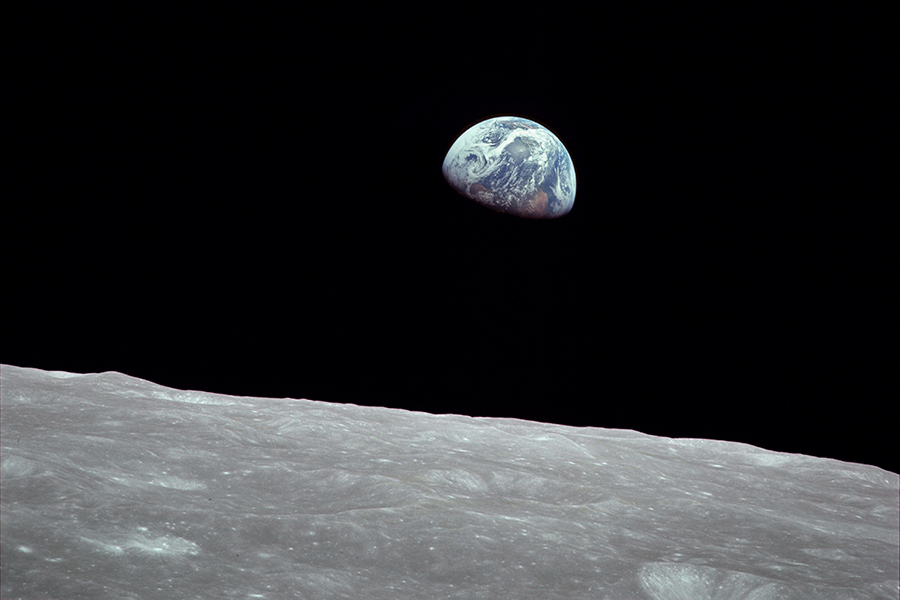Fund NASA: To Space for Earth
Earthrise, the photo of the Earth rising above the Lunar surface, was taken by astronaut Bill Anders on Dec. 24, 1968 during the Apollo 8 mission. “We set out to explore the moon and instead discovered the Earth,” Anders said.
The 2020 California wildfire season has produced four of the five largest fires ever recorded in the
state, killing 31 people and destroying 10,488 buildings. Throughout the disaster, an array of scientific instruments on NASA satellites and aircraft mapped fires from above, helping firefighters locate fires and providing public health officials with information on the spread of dangerous wildfire smoke. Since NASA built the first weather satellite in 1960, the information the satellites provide have warned many of oncoming natural disasters.
This is just one of the many ways NASA — which receives a mere half-percent of the total federal budget — saves and improves lives worldwide.
NASA tracks worldwide changes in ice sheets, sea-level rise and carbon dioxide levels, which is particularly important in unreachable locations. By providing the information gathered freely, they play a critical role in the fight against climate change.
Furthermore, innovations developed by NASA have come to the rescue in immediate life or death situations. When an Iraqi village’s only well failed, its population rapidly dwindled without access to clear water. In response, a filtration system developed for recycling wastewater on the International Space Station was set up, and has since been installed in communities worldwide. Out at sea, a satellite-based search and rescue system has helped rescue 30,000 people, even in the middle of the Indian Ocean. While space exploration is sometimes seen as shifting the focus of government spending away from solving issues on Earth, NASA is critical to innovating novel humanitarian solutions that were only created because of space exploration efforts. Instead of seeing these two aims as mutually exclusive, we need to think about the ways in which they complement each other.
Exploring space also satiates curiosity, enabling us to seek answers to questions. Notably, investigating other planets helps us understand our own planet. Venus could have had oceans of water on its surface, but a runaway greenhouse effect has replaced it with surface temperatures hot enough to melt lead. While Earth will likely not resemble Venus, what happened there can provide insights on climate evolution. Through space exploration, we have the opportunity to gain a fuller perspective of our place in the universe by answering questions we can currently only speculate about: whether life on Earth is alone, where it came from and much about the earliest moments of the universe.
We depend on NASA to protect against interplanetary threats. The NASA Authorization Act of 2005 gave the organization the responsibility of cataloging 90% of all asteroids near Earth over 140 meters in diameter — an impact from an object of that size would cause an average of 43,600 deaths and injuries. Currently, several telescopes search the night sky for Near Earth Objects that could pose a risk, helping us discover asteroids that could strike Earth.
In 2022, NASA’s Double Asteroid Redirection Test (DART) will test the technology necessary to deflect asteroids from a collision course with Earth. The spacecraft will impact Dimorphos, the moon of the asteroid Didymos, and telescopes on Earth will analyze the subsequent effect on the moon’s orbit.
For now, however, we have no way of stopping death and destruction from above. In February 2013, a 13,000 ton asteroid exploded over Chelyabinsk, Russia with the energy of a nuclear weapon, blowing out windows and seriously injuring nearly 1,500 people. Aside from a blinding fireball streaking overhead, there was no warning.
As Apollo 8 orbited the Moon — the first crewed mission to do so — the Earth emerged from the horizon. When the last crewed mission to the Moon, Apollo 17, returned from the Moon, they were the only people to witness the fully illuminated disk of the Earth. The photos taken in those moments depicted a lonely, fragile world in the endless void of space. Known as “Earthrise” and “The Blue Marble” respectively, both photos became quintessential symbols for the emerging environmental movement and became some of the most distributed photographs in history. Through the cultural impact of a new perspective, NASA empowers people to take the action necessary to protect Earth.
Though space exploration may take humans farther from the Earth, NASA improves countless lives on Earth with a modest budget. While private companies like SpaceX have brought a flurry of innovations to the space industry, NASA is critical to supporting those very companies and pursuing initiatives without the need for profit. When those initiatives concern the future of human life on Earth, their importance cannot be overstated. Unfortunately, NASA projects, from crewed Moon landers to satellites investigating the carbon cycle, constantly face the threat of cancellation or underfunding in the tug of war between the houses of Congress and the President when finalizing federal spending.
NASA may not be the most immediate political issue, but the contributions it makes with just a half penny on a tax dollar show why it deserves the funding necessary to truly fulfill its mission: “Reach for new heights and reveal the unknown for the benefit of humankind.”











